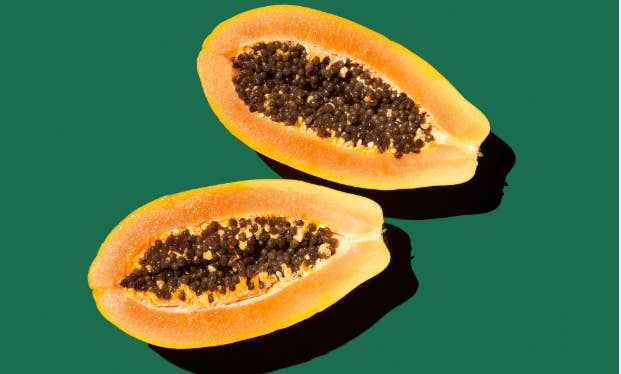
A Guide to Finding Perfectly Ripe Papayas (Plus: The Scoop on Green Papaya)
Any papaya lover will tell you that the key to enjoying a papaya in all its sweet, creamy-fleshed splendor is finding a fruit that was picked at full maturity and has reached peak ripeness. Read on for how to do that, plus, how to prepare and store them so they stay perfectly ripe and fresh.
Large vs. Small Papayas
Native to Mexico and Central America, papayas are hugely popular in tropical regions around the globe—right up there with bananas, pineapples, and mangoes.
Papayas fall into two general categories: large Mexican and small Hawaiian varieties. Mexican papayas (sometimes called Caribbean) look like elongated melons and can grow to up to 10 pounds. Hawaiian (aka Solo) papayas are oval-shaped and small, weighing in at just 1 pound. Both types have thin skin and sunset-hued soft, juicy, fragrant flesh, though Mexican papaya varieties tend to be muskier and less sweet than Hawaiian. Both also contain papain, an enzyme unique to papayas that has anti-inflammatory properties and can aid digestion.
How to Tell if a Papaya Is Ripe
So, how do you know when a papaya is perfectly ripe and ready to eat? Check the skin. As papayas ripen, their skin color goes from green to bright yellow (for Hawaiian papayas) or orange-gold (Mexican papayas). The skin should also give a little when you press gently on the fruit, and it should give off a sweet, fragrant aroma.
Papaya Shopping and Storage
Papaya is available year-round, but American-grown papaya is in season from May through September. Always look for papayas with no soft spots or bruises. Beyond that, what to look for when you select a papaya depends on when you will be eating it. For immediate use, choose fruit that is mostly or entirely yellow or golden. Otherwise, choose a papaya that has at least a yellowish tinge at the base. Avoid any fruit that has black spots or blemishes, even if it looks ripe. These can indicate mold or mildew infestation of the fruit on the tree and often mean the fruit will never develop or ripen properly.
Fully ripe papayas should go straight to the fridge to maintain their juiciness and flavor. Store still-green papayas at room temperature until they ripen and turn yellow. To speed the process, place the fruit in a paper bag with an apple or a banana. The ethylene gas that apples and bananas emit induces ripening in other fruits when placed nearby.
Another papaya buying option is fresh cut papaya from the refrigerator case. Pre-cut papaya chunks should be bright and firm with little to no liquid collecting at the bottom of the package. Be sure to check the packing date to find out when the fruit was packaged: The longer it has sat in the case, the less flavorful it will be.
How Long Does Papaya Last in the Fridge?
Whole, uncut papaya will last for three to five days in the refrigerator once ripe, but should be consumed sooner than later because they do get mushy over time.
How to Cut a Papaya
If you know how to cut and seed a melon, then you already know how to prep a papaya. Here are the basic steps.
1. Rinse or wipe down the whole papaya, to remove any dust or dirt.
2. Cut the cleaned papaya in half lengthwise, then pull the halves apart and scrape out the black seeds in the fruit’s cavity. (The seeds are edible and have a peppery flavor.)
3. Scoop out the orange flesh with a spoon or slice away the bitter skin and cut the fruit into wedges or cubes. Enjoy!
Alternatively, you can remove the skin with a vegetable peeler before halving and seeding the papaya, though this can be messy if the fruit is really ripe.
Tasty Ways to Enjoy Papaya
Got a papaya that’s ripe and ready? Here are a few ideas for how to eat it.
- Like a melon: Halve and seed a small Hawaiian papaya, then eat it like a halved melon: with a spoon and a squeeze of lime.
- In Thai Fruit Skewers, where it’s infused with coconut milk, lime, and cayenne and served alongside pineapple, mango, and kiwi.
- As a toast topper: Mash freshly cut papaya on toast for a pure fruit alternative to jam.
- Grilled: Throw wedges of Mexican papaya or Hawaiian papaya halves on the grill for a sweet, smoky dessert treat.
- Nice Cream: Blending papayas into a frozen treat is a favorite way to use the fruit in Brazil.
- In a Tropical Soba Noodle Bowl where it’s paired with pineapple.
- Fruit Salsa: Use it in place of or in addition to other fruits in a spicy salsa.
- Bean and Grain Salads: Add it to an Easy Black Bean Salad or a Quinoa, Corn, and Avocado Salad.
- Salad Dressing: Blend 2 cups of papaya chunks with 1 Tbsp. papaya seeds for a spicy-sweet dip or salad topper.
The Scoop on Green Papaya
Green papayas are picked underripe, and their crisp, white flesh is prepared like a vegetable in Southeast Asian cuisines. Green papayas get star billing in Som Tum, a Thai salad made with green papaya. They also make their ways into curries, pickles, soups, and stews. Try adding green papaya to salads or pickling it with other vegetables.
An Easy Green Papaya Substitute
If you need a substitute for green papaya in a recipe, use a Granny Smith apple, which has a similar taste and texture.

About the Author

About the Author
Mary Margaret Chappell
Join our mailing list
Get free recipes and the latest info on living a happy, healthy plant-based lifestyle.
By providing your email address, you consent to receive newsletter emails from Forks Over Knives. We value your privacy and will keep your email address safe. You may unsubscribe from our emails at any time.